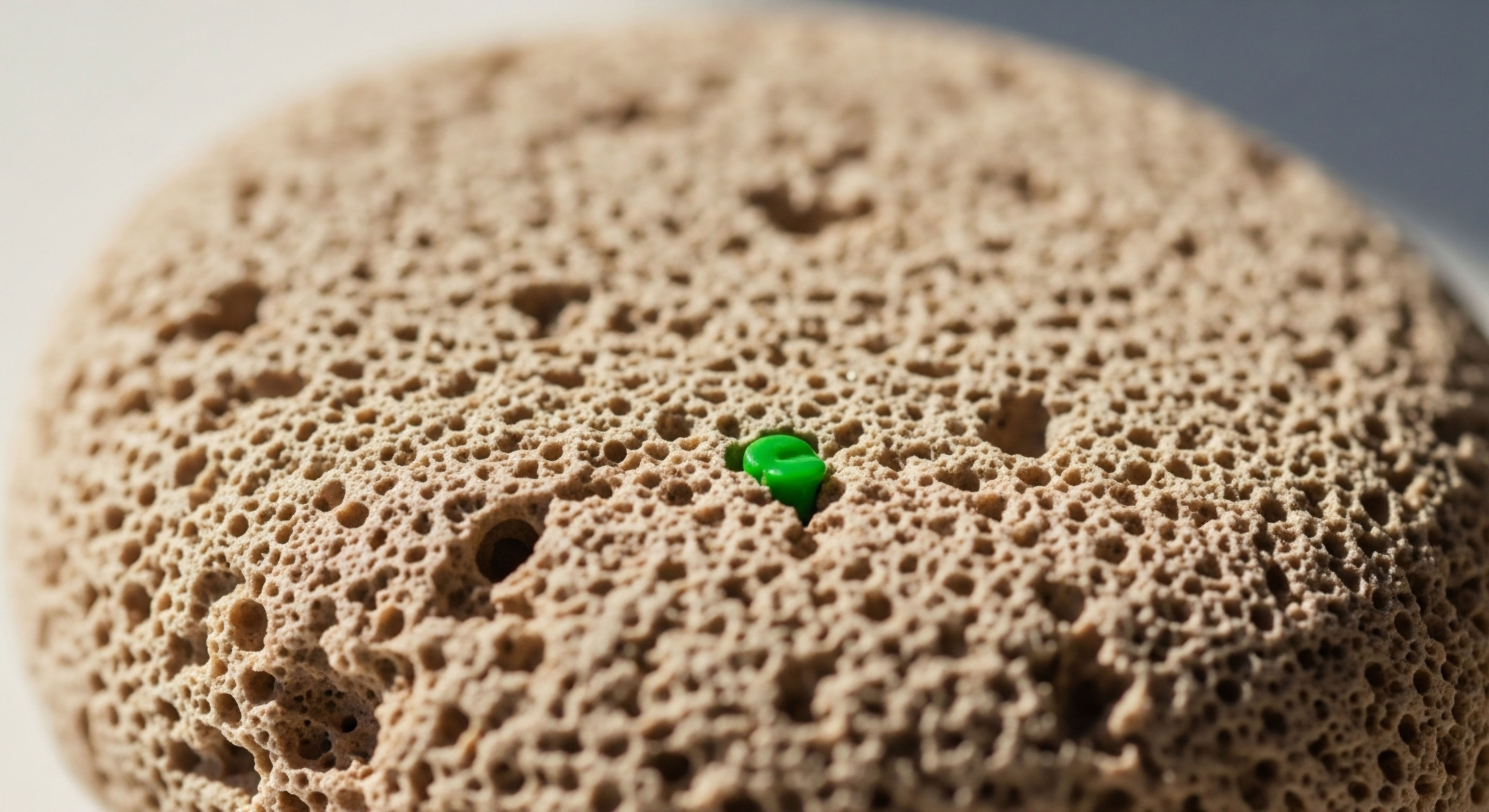

Fundamentals
You feel it in your bones, a shift in your body’s internal landscape. Perhaps it’s a persistent fatigue that sleep doesn’t resolve, a change in your mood, or a subtle but frustrating alteration in your physical composition.
Your internal dialogue likely centers on hormones like testosterone or estrogen, yet a critical component of this complex system is often overlooked Sex Hormone Binding Globulin, or SHBG. Understanding SHBG is fundamental to comprehending your own biological narrative. It is the master regulator, the protein that dictates how much of your vital sex hormones are active and available to your cells at any given moment.
Think of your hormones as powerful messengers and SHBG as the sophisticated delivery service that transports them through your bloodstream. The majority of your testosterone and estradiol are bound to SHBG, held in reserve. Only a small, unbound fraction, known as “free” hormone, is biologically active and capable of entering cells to exert its effects.
The concentration of SHBG in your blood, therefore, directly modulates your hormonal potency. High levels of SHBG mean more hormones are bound and inactive, while low levels result in a higher proportion of free, active hormones. This delicate balance is central to your well-being.
The concentration of Sex Hormone Binding Globulin in your blood directly dictates the availability and activity of your sex hormones.
The question of whether lifestyle can fully stand in for clinical protocols to manage SHBG is a deeply personal one, rooted in individual biology. The answer lies in understanding the powerful forces that govern SHBG production, primarily within the liver. This process is exquisitely sensitive to your metabolic state.
Factors like insulin sensitivity, body composition, and inflammation send constant signals to the liver, instructing it to either increase or decrease SHBG synthesis. This is where your daily choices exert their profound influence. The foods you consume, the way you move your body, and your overall metabolic health are in direct communication with the machinery that controls your hormonal availability.

The Metabolic Connection to SHBG
Your body’s hormonal system operates as an interconnected web, with metabolic health at its center. Low SHBG is a well-established marker for metabolic dysfunction, particularly insulin resistance. When your cells become less responsive to insulin, a state often associated with excess body fat and a diet high in refined carbohydrates, the liver receives signals to downregulate SHBG production.
This creates a feedback loop. The resulting increase in free hormone activity can, in some contexts, exacerbate certain conditions. For instance, in women, elevated free testosterone can lead to symptoms like acne and unwanted hair growth.
Conversely, conditions that improve insulin sensitivity and reduce inflammation can prompt the liver to produce more SHBG. This is the biological basis for lifestyle interventions. They are not merely about calories or weight on a scale; they are about recalibrating the metabolic signals that govern your entire endocrine system. By optimizing these inputs, you can directly influence your SHBG levels and, by extension, your hormonal equilibrium.

Understanding Your Individual Baseline
Every individual possesses a unique hormonal constitution. What constitutes a “normal” or optimal SHBG level is not a single number but a range that shifts throughout life. Age, genetics, and underlying health conditions all contribute to your personal SHBG baseline.
For men, a gradual decline in testosterone is a natural part of aging, and lifestyle factors can influence the rate of this decline. For women, the hormonal fluctuations of the perimenopausal and postmenopausal years bring significant changes to SHBG and its interplay with estrogen and testosterone. Recognizing where you are in your life’s journey is a key step in understanding your lab results and what they mean for your lived experience.
The goal is a state of optimization, a level of SHBG that is neither too high nor too low, but perfectly calibrated to support your unique physiology. Achieving this requires a partnership between personal effort and, when necessary, clinical guidance. It begins with the empowering knowledge that your actions have a direct and measurable impact on your hormonal health.


Intermediate
Moving beyond foundational knowledge, the central question becomes one of application ∞ can deliberate lifestyle changes achieve the same SHBG modulation as targeted hormonal therapies? The answer involves a nuanced understanding of mechanism and magnitude. Lifestyle interventions and hormonal protocols represent two distinct, yet potentially complementary, pathways to influence SHBG levels.
The former focuses on altering the body’s internal metabolic environment to encourage a natural shift in SHBG production, while the latter uses exogenous hormones to directly manipulate the endocrine system’s feedback loops.

Lifestyle Interventions the Power of Metabolic Recalibration
Lifestyle-based strategies for SHBG modulation are fundamentally about improving metabolic health. The liver’s production of SHBG is highly responsive to insulin levels, inflammation, and body composition. Therefore, interventions that target these areas can produce significant changes in SHBG concentrations. These are not passive wellness suggestions; they are active, evidence-based therapeutic inputs.

Key Lifestyle Modulators
- Weight Management A reduction in body fat is one of the most effective ways to increase SHBG. Excess adipose tissue, particularly visceral fat, promotes insulin resistance and inflammation, both of which suppress SHBG synthesis by the liver. Losing weight helps to reverse these processes, leading to a natural rise in SHBG levels.
- Dietary Composition The type of calories consumed is as important as the quantity. Diets high in refined carbohydrates and sugars drive up insulin, which in turn drives down SHBG. Conversely, a diet rich in fiber has been shown to support higher SHBG levels. The inclusion of foods containing phytoestrogens, such as flax seeds, may also contribute to an increase in SHBG.
- Physical Activity Regular exercise, encompassing both aerobic and resistance training, improves insulin sensitivity independently of weight loss. This enhanced cellular response to insulin reduces the primary signal that suppresses SHBG production, allowing levels to normalize or increase.
Lifestyle interventions function by improving the body’s underlying metabolic health, which in turn signals the liver to adjust SHBG production.

Hormonal Optimization Protocols Direct Endocrine Manipulation
Hormonal optimization protocols, such as Testosterone Replacement Therapy (TRT) for men and women, operate on a different principle. They introduce exogenous hormones into the body, which directly influences the Hypothalamic-Pituitary-Gonadal (HPG) axis and SHBG levels. These protocols are designed to restore hormonal balance when the body’s endogenous production is insufficient or when specific therapeutic effects are desired.

TRT Protocols and Their Impact on SHBG
In men with clinically low testosterone (hypogonadism), TRT is a standard intervention. The administration of Testosterone Cypionate aims to restore testosterone to a healthy physiological range. This intervention has a predictable effect on SHBG.
| Approach | Primary Mechanism | Typical Magnitude of Effect | Primary Candidates |
|---|---|---|---|
| Lifestyle Interventions | Improved insulin sensitivity, reduced inflammation, fat loss | Variable, dependent on baseline and adherence | Individuals with metabolic dysfunction, overweight, or insulin resistance |
| Hormonal Protocols (TRT) | Direct hormonal signaling, feedback loop suppression | Predictable decrease in SHBG | Individuals with diagnosed hypogonadism or specific therapeutic goals |
The introduction of exogenous testosterone signals the pituitary gland to reduce its output of Luteinizing Hormone (LH), which in turn reduces the testes’ own production of testosterone. This process also typically leads to a decrease in SHBG levels. This effect can be therapeutically beneficial, as it increases the proportion of free, biologically active testosterone.
For a man starting TRT with high SHBG and low free testosterone, the therapy-induced drop in SHBG can be a primary mechanism for symptom relief. Medications like Gonadorelin are often co-administered to help maintain some natural testicular function by mimicking the body’s own signaling hormones.

Can Lifestyle Replace Clinical Protocols?
For some individuals, particularly those whose low SHBG is a direct consequence of metabolic syndrome, insulin resistance, or being overweight, intensive lifestyle interventions can be profoundly effective. In these cases, addressing the root metabolic cause can normalize SHBG levels to such an extent that hormonal therapy may become unnecessary. A study on the Diabetes Prevention Program demonstrated that intensive lifestyle changes led to significant increases in SHBG, primarily attributable to improvements in adiposity.
However, for individuals with primary hypogonadism, where the testes fail to produce adequate testosterone regardless of metabolic health, lifestyle changes alone are insufficient to correct the deficiency. Similarly, for a person with excessively high SHBG that binds too much testosterone, a TRT protocol designed to lower SHBG and increase free testosterone may be the most direct and effective path to symptom resolution.
The two approaches are not mutually exclusive. An individual on TRT will still derive immense benefit from optimizing their diet and exercise, as this improves the body’s overall response to the therapy and supports long-term health.


Academic
An academic exploration of Sex Hormone Binding Globulin (SHBG) requires a shift in perspective from systemic effects to the molecular and genetic underpinnings of its regulation. The question of whether lifestyle can supplant hormonal therapy for SHBG modulation is resolved at the level of hepatic gene expression and the intricate interplay of transcription factors that govern the synthesis of this critical glycoprotein.
The liver is the primary site of SHBG production, and its synthesis is controlled by a complex network of hormonal and metabolic signals that converge on the SHBG gene promoter.

Transcriptional Regulation of the SHBG Gene
The production of SHBG is primarily regulated at the level of gene transcription in hepatocytes. The key transcription factor involved in this process is Hepatocyte Nuclear Factor 4 alpha (HNF-4α). This nuclear receptor acts as a master regulator of a vast array of liver-specific genes, including SHBG. The activity of HNF-4α is, in turn, modulated by a cascade of upstream signaling pathways that are sensitive to the metabolic state of the organism.
Insulin is a potent suppressor of SHBG synthesis. The mechanism involves the insulin-stimulated activation of the phosphoinositide 3-kinase (PI3K)/Akt signaling pathway. This cascade leads to the phosphorylation and subsequent downregulation of HNF-4α activity, thereby reducing the transcription of the SHBG gene.
This direct molecular link explains the strong inverse correlation observed between circulating insulin levels and SHBG concentrations. Conditions characterized by hyperinsulinemia, such as metabolic syndrome and type 2 diabetes, are thus biochemically destined to result in low SHBG levels.
The regulation of SHBG synthesis is a direct reflection of the liver’s metabolic status, primarily controlled by the transcription factor HNF-4α and its suppression by insulin signaling pathways.

The Role of Thyroid Hormones and Estrogens
While insulin is a primary suppressor, other hormones act as potent stimulators of SHBG transcription. Thyroid hormones (T3 and T4) and estrogens both increase SHBG production. They achieve this by binding to their respective nuclear receptors, which then interact with specific hormone response elements on the SHBG gene promoter, enhancing its transcription.
This explains why hyperthyroidism is associated with high SHBG levels and why women, who have higher circulating estrogen levels, generally have higher SHBG concentrations than men. The use of oral contraceptives containing synthetic estrogens can dramatically increase SHBG levels, a direct consequence of this transcriptional activation in the liver.
| Regulator | Primary Signaling Pathway | Effect on SHBG Transcription | Associated Clinical State |
|---|---|---|---|
| Insulin | PI3K/Akt pathway | Suppression (via HNF-4α inhibition) | Metabolic Syndrome, Type 2 Diabetes |
| Estrogen | Estrogen Receptor (ER) activation | Stimulation | Higher levels in females, oral contraceptive use |
| Thyroid Hormone | Thyroid Hormone Receptor (TR) activation | Stimulation | Hyperthyroidism |
| Androgens | Androgen Receptor (AR) activation | Suppression | Higher free testosterone, TRT use |

How Do Lifestyle Interventions Exert Their Effects?
Lifestyle interventions, such as dietary modification and exercise, function by altering the upstream metabolic signals that regulate HNF-4α activity. A low-glycemic diet and weight loss reduce circulating insulin levels, which alleviates the chronic suppression of HNF-4α. This disinhibition allows for an increase in SHBG gene transcription, leading to higher circulating SHBG levels.
Research from the Diabetes Prevention Program supports this, showing that intensive lifestyle changes increased SHBG, an effect largely mediated by reductions in adiposity and the associated improvements in insulin sensitivity.
The efficacy of these interventions is therefore directly proportional to their ability to correct the underlying metabolic dysfunction. In a state of severe insulin resistance, the signaling environment is so overwhelmingly suppressive that lifestyle changes, while beneficial, may not be sufficient to restore SHBG to an optimal range without a very high degree of adherence and physiological response.

The Molecular Impact of Hormonal Protocols
Hormonal optimization protocols, in contrast, bypass these metabolic signaling pathways and act directly on the hormonal regulation of the SHBG gene. The administration of exogenous testosterone in TRT introduces a strong androgenic signal to the liver. Androgens, acting via the androgen receptor, are known to suppress SHBG transcription.
This direct suppressive effect is why TRT reliably lowers SHBG levels, thereby increasing the free androgen index. This is a targeted pharmacological intervention designed to achieve a specific biochemical outcome that may not be achievable through metabolic recalibration alone, especially in cases of eugonadal high-SHBG states or primary testicular failure.

Genetic Predisposition and Individual Variability
It is also essential to acknowledge the role of genetic polymorphisms in the SHBG gene. Variations in the gene sequence can lead to differences in baseline SHBG levels among individuals, independent of their metabolic or hormonal status.
These genetic factors can influence an individual’s response to both lifestyle and hormonal interventions, creating a layer of complexity that underscores the need for personalized clinical assessment. The decision to use lifestyle interventions as a standalone approach versus a component of a broader hormonal optimization strategy depends on a sophisticated analysis of the patient’s entire metabolic and endocrine profile, including their underlying diagnosis, hormonal status, and genetic predispositions.

References
- Goldring, Steve. “Sex Hormone Binding Globulin | SHBG | Ride Sharing for Hormones.” YouTube, 30 July 2024.
- Kim, C. et al. “Circulating sex hormone binding globulin levels are modified with intensive lifestyle intervention, but their changes did not independently predict diabetes risk in the Diabetes Prevention Program.” BMJ Open Diabetes Research & Care, vol. 8, no. 2, 2020, e001736.
- “What Is A Normal Testosterone Level For Your Age?” Medichecks, 31 December 2024.
- Skrzypulec-Plinta, V. et al. “New Insights in the Diagnostic Potential of Sex Hormone-Binding Globulin (SHBG) ∞ Clinical Approach.” Journal of Clinical Medicine, vol. 11, no. 10, 2022, p. 2796.
- “Sex Hormone Binding Globulin (SHBG) 101.” Clue, 16 July 2019.

Reflection

What Does Your Biology Ask of You?
You have now seen the intricate machinery that governs a single, vital protein in your body. The regulation of SHBG is a conversation between your genes, your hormones, and your daily choices. The knowledge that a meal, a workout, or a prescribed therapy can alter this delicate balance is powerful.
This information is the starting point of a more profound inquiry. It invites you to look inward and consider the unique signals your body is sending. Are the symptoms you feel a reflection of metabolic imbalance, a shift in primary hormone production, or a combination of factors? Understanding these systems is the first step. The next is to decide how you will respond to the specific needs of your own physiology, beginning a personalized path toward reclaiming your vitality.



